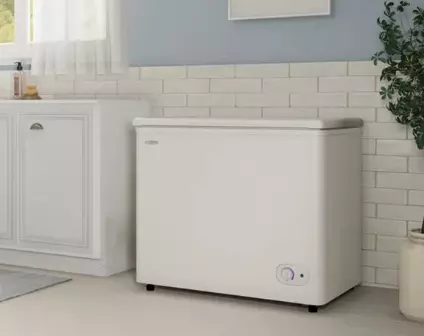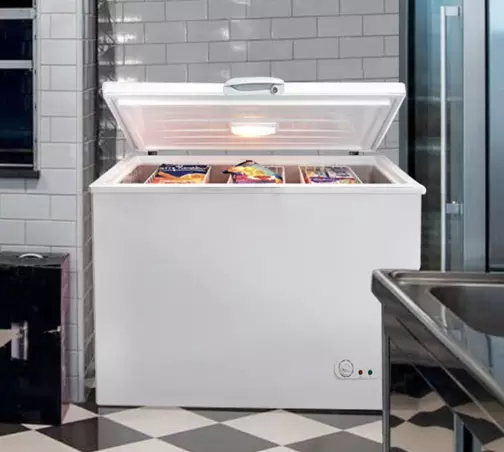Chest freezers are a popular option for both homes and businesses because of their great capacity for storage and propensity to keep a constant low temperature. Chest freezers need to be manually defrosted, unlike their frost-free competitors, to get rid of the ice and frost that might build up over time.
Are chest freezer frost free? I’m sorry to disappoint you, but a chest freezer does not provide frost-free storage. Many users discover that the advantages of a chest freezer much exceed the hassle of periodic defrosting, despite the fact that this may be an additional maintenance task.
Difference between Self-Defrosting vs Manual Defrost Freezer
Self-Defrosting Freezer:
- Functionality: Self-defrosting freezers have an automated defrosting system that periodically clears away buildup frost.
- Frost Management: The freezer uses a heating element to melt accumulated frost, which then drains away as water.
- Convenience: No manual intervention or defrosting process is required, saving time and effort for the user.
- Temperature Maintenance: Self-defrosting freezers keep their interior temperatures more consistent, which minimizes temperature swings and protects the quality of their contents.
- Storage Capacity: The automatic defrosting system may occupy some space within the freezer, potentially reducing the available storage area.
- Energy Efficiency: When compared to manual defrost freezers, continuous use of the defrosting process may result in a modest increase in energy usage.
Manual Defrost Freezer:
- Defrosting Process: To get rid of built-up frost and ice, manual defrost freezers need to be manually defrosted on time.
- User Intervention: The user needs to manually initiate the defrosting process by unplugging the freezer, allowing it to thaw, and removing the melted water.
- Frequency of Defrosting: Manual defrost freezers typically require defrosting every few months, depending on the amount of frost buildup.
- Maintenance: Regular defrosting helps maintain optimal freezer performance and prevents excessive frost buildup.
- Storage Capacity: As an automated defrosting method does not occupy a specific area, manual defrost freezers often offer the highest storage capacity.
- Energy Efficiency: Manual defrost freezers are generally more energy-efficient since they do not have a continuous defrosting cycle.
Choosing Between Self-Defrosting and Manual Defrost Freezers:
- Consider your preference for convenience versus occasional maintenance.
- Consider the significance of maintaining a consistent temperature and food quality.
- Assess available storage space and energy consumption considerations.
- Determine the frequency of freezer usage and the amount of frost buildup expected.
Ultimately, the choice between self-defrosting and manual defrost freezers depends on individual needs and priorities.

How long does it take for a chest freezer to reach its optimal freezing temperature?
The time it takes for a chest freezer to reach its optimal freezing temperature can vary depending on various factors such as the size of the freezer, the initial temperature of the items being stored, and the ambient temperature in the room. However, on average, it usually takes between 4 and 6 hours for a chest freezer to reach its desired freezing temperature.
During the initial startup, it is recommended to set the freezer to its coldest setting to expedite the cooling process. This allows the compressor to work at maximum capacity and cool the freezer rapidly. The insulation of the freezer also plays a role in the time it takes to reach the optimal freezing temperature. Well-insulated freezers tend to cool down more efficiently and faster compared to those with poor insulation.
To help speed up the cooling process and ensure optimal freezing, here are a few tips:
- Pre-cooling: If possible, pre-cool any items or food you plan to store in the freezer. This helps reduce the initial temperature load and allows the freezer to reach its desired temperature more quickly.
- Proper Air Circulation: Ensure that there is sufficient space around the freezer for proper air circulation. Avoid placing the freezer against walls or near heat sources, as this can hinder the cooling process.
- Avoid Overloading: Overloading the freezer with a large quantity of warm items can prolong the time it takes to reach the optimal freezing temperature. It is best to stagger the addition of items and leave enough room for air to circulate within the freezer.
- Monitor the Temperature: Use a thermometer to monitor the temperature inside the freezer. Once the desired freezing temperature is reached, typically around 0 °F (-18 °C), you can begin storing your items.
By following these tips and allowing sufficient time for the freezer to reach its optimal freezing temperature, you can ensure that your frozen foods are preserved at their best quality for an extended period.
Conclusion
Chest freezers are typically not frost-free appliances. Unlike frost-free refrigerators, which have a built-in mechanism to prevent frost buildup, chest freezers rely on manual defrosting to remove accumulated ice and frost. This means that over time, frost will develop inside the freezer, requiring regular maintenance to keep it frost-free.
While not having a frost-free function can seem like a disadvantage, chest freezers provide a number of benefits over frost-free models. They are perfect for bulk storage of frozen foods since they typically have bigger storage capacity. Furthermore, chest freezers frequently use less energy and can sustain a constant temperature for a long time, even during power outages.
